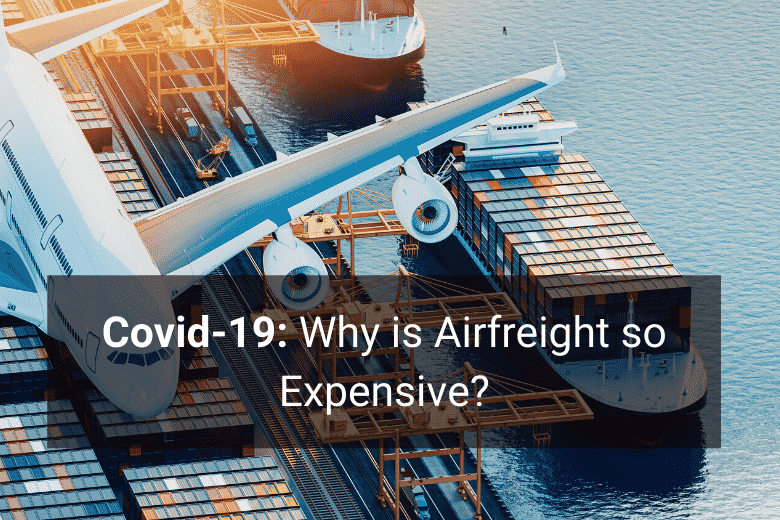COVID-19 has brought about widespread travel restrictions, from border closures to mandatory lockdowns. It should come as no surprise that the air travel industry has been greatly hurt, with the number of commercial flights down by 73.7% from April 2019 to April 2020. Some domestic travel is still allowed, but demand for international flights has dropped to almost zero, and airlines have cut many of their long-haul international flights making airfreight expensive.
In theory, this is a win-win situation. Instead of flying empty or near-empty planes, airlines can cut the associated expenses entirely. Many governments are covering the salaries of furloughed employees, so employees do not take the hit. And fewer flights means reduced carbon emissions, with some estimates showing a reduction in emission as high as 47 million tons thanks to COVID-19.
And yet, the price of airfreight has skyrocketed. Flights between Asia and the US, which normally can be chartered for around $500,000, are costing freight operators between $1.3M and $1.7M — more than triple their pre-COVID-19 rates.
Why Is Airfreight So Expensive?
A typical passenger plane carries more than just passengers; around 45% of the world’s cargo is carried on passenger flights. With thousands of passenger flights grounded for the foreseeable future, the world’s air cargo capacity dropped by nearly 50%.
As the global economy has stagnated because of COVID-19, this drop would seem inconsequential. Consumers should be making fewer purchases, and companies should have fewer goods to ship.
But recall that the economy is stagnating because of a public health crisis. COVID-19 is highly infectious, with R-values estimated somewhere between 2 and 6 in its early stages (The R-value represents the average number of people one infected person spreads the virus to). To keep the disease from spreading, healthcare centers need more personal protective equipment (PPE) such as gloves, gowns, and masks for all their employees to wear virtually all the time. Few, if any, healthcare centers had enough protective gear when COVID-19 first hit.
Because the disease spread so rapidly, the worldwide demand for PPE skyrocketed overnight. Hotspot countries like the US and Italy were unable to manufacture enough for themselves, either because of lack of infrastructure or the amount of time it would take to scale manufacturing.
Conveniently, the world’s number one manufacturer of PPE was also the first country affected: China, providing half the world’s pre-COVID-19 PPE supply of masks (20M per day). By the end of March, China was producing over 100M masks per day to meet their own demand and that of countries worldwide.
But getting those masks from China to other regions of the world required international and intercontinental shipping.
Enter airfreight…
The need for PPE meant that air cargo demand only dropped by 15% in March 2020. But air cargo capacity dropped by 23% due to the loss of passenger flights. 8% may seem like a small margin, but for a global industry, this was a substantial gap to bridge.
Because there was a greater demand than supply, costs skyrocketed, especially between Asia and the US/European markets. Air cargo rates from Hong Kong to the US jumped by 27% at the end of March, and rates from Shanghai to Europe increased by 50%.
Demand was up — and airlines were eager to meet it.
Covid-19 Shipping Strategies
Covid-19 Trending Products and Global Shipping Solutions

Shipping Orders Internationally During CoronaVirus Pandemic
Floship · FloCast: Skubana X Floship CEO’s Talk About Covid-19 & Trade Wars Impact on E-Commerce Businesses
How Airlines Pivoted to Meet the Demand
This proved to be a perfect opportunity for airlines. Planes were sitting empty, pilots and staff were being paid to do nothing, and there was a substantial unmet demand for airfreight.
Even better, because the demand for passenger flights had dropped, so did the price of jet fuel.
For the first time, airlines could turn a profit flying a passenger plane with no passengers.
Nearly 20 airlines took advantage of their empty planes by filling the holds — now free of passenger luggage — with all the cargo they could carry. Some airlines brought old planes out of storage to meet the demand; others began strapping cargo into passenger seats to fit as much cargo as possible.
Nevertheless, passenger planes still lack the capacity of their freighter counterparts. Converting passenger planes into makeshift freighters has helped to bridge the gap between supply and demand, but the demand for air freight is still substantial and has not been entirely met by this additional capacity.
Trending eCommerce Products During COVID-19
Another strain on airfreight space is eCommerce. With store closures and stay-at-home orders, the demand for eCommerce is on the rise. One study found that 24% of consumers wouldn’t feel comfortable shopping in a mall for more than six months because of COVID-19, and recent studies show that 43% of eCommerce merchants have seen an increase in sales. While the pandemic has led to some tapering in consumer purchasing, consumers are more likely than ever to go online for the goods they need.
According to one source, categories seeing the most growth in sales are essentials such as food and beverage, up 7.2%; recreation and home goods such as toys & games, up 7%, and home & garden, up 8.4%.
Of course, not all categories are growing. Luggage sales are down 77% from this time last year. Swimwear sales are down 62% and gym bags are down 57%. This is hardly surprising. With travel discouraged and pools, beaches, and gyms closed, consumers are less inclined to invest in these goods until it becomes clear when they will be necessary once again.
The Impact of Air Cargo Space on eCommerce
Because PPE is in short supply and healthcare centers are unable to wait weeks for its arrival, organizations are willing to pay a premium to have it delivered by air. Higher prices and poor availability of international shipping are expected to last until COVID-19 is contained and the demand for PPE lessens.
With greater demand for their goods and less airfreight availability, some eCommerce companies are struggling. International shipments are either being delayed as they wait for space or opt for ocean transit, or have become more expensive than ever.
Other Articles About Covid-19
Covid-19 Trending Products and Global Shipping Solutions

Shipping Orders Internationally During CoronaVirus Pandemic

How eCommerce Fulfillment Companies Can Help
Navigating this new shipping landscape can be daunting for eCommerce companies. Many have seen the lengthy shipping delays from Amazon and worried that if this logistical nightmare was too much even for a large corporation to handle, how could a smaller eCommerce merchant figure it out?
Fortunately, there are ways to ease the stresses of shipping during COVID-19. eCommerce fulfillment companies like Floship take the nightmare out of logistics by managing all aspects of fulfillment for you. Our main warehouses are located in Hong Kong, which is the world’s largest airfreight hub, and with the amount of PPE going from Asia to hubs around the world it is no less active. Shipping from Hong Kong is less expensive and faster than from practically anywhere else. Because we monitor our clients’ stock in our warehouses and notify them if they are getting low, our clients have an easier time keeping up with the increased demand and ensuring they order enough inventory in time.
Floship also handles all the regulations and tariffs associated with international shipping. During a pandemic, when national borders are more tightly controlled and travel is more difficult, having an expert handle your shipping can be a significant time-saver.
Conclusion
Now we understand why airfreight became so expensive. Once COVID-19 passes, the consumer and travel industries will not bounce back to normal overnight. In all likelihood, COVID-19 will have changed consumer behaviors forever, and eCommerce merchants must be ready to meet the demand. Having an international shipping partner to handle the logistics, even after airfreight is back to normal, could be critical to building a thriving post-COVID-19 business.
Solid Shipping Strategy During and After Covid-19
Fill out our get global solution form and one of our fulfillment solution experts will be in touch with you to go over a solid shipping strategy for your e-commerce business or crowdfunding campaign. Our goal is to understand your business and the challenges you’re facing. During our conversation it will become clear what solutions would best suit your business’ needs. Sign up today and start saving on shipping.

Ready To Upgrade Your Logistic Solution?
Speak to Floship ecommerce logistic consultant about improving your global support chain today




